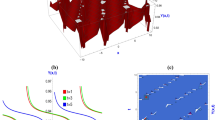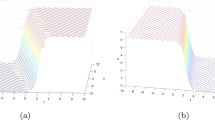Abstract
The Yajima–Oikawa (YO) system is an important long-wave–short-wave resonant interaction model, which can be used to describe a fascinating resonance phenomena in diverse areas, such as hydrodynamics, nonlinear optics and biophysics. In this paper, we propose a new type integrable nonlocal YO system, which can be derived from the special reduction in the two-component YO system. We show that the binary Darboux transformation is an effective method to construct not only multi-soliton solutions, but also other types of solutions for this type nonlocal integrable systems. Additionally, some novel solutions of the nonlocal YO system are obtained, and further are analyzed in detail to reveal several interesting dynamic features, such as the moving bright soliton with sudden position shift, the collision of two-breather waves.



Similar content being viewed by others
Data availability
No datasets were generated or utilized in this study.
References
Ablowitz, M.J., Musslimani, Z.H.: Integrable nonlocal nonlinear Schrödinger equation. Phys. Rev. Lett. 110, 064105 (2013)
Ablowitz, M.J., Musslimani, Z.H.: Integrable discrete PT-symmetric model. Phys. Rev. E 90, 032912 (2014)
Grahovski, G.G., Mustafa, J.I., Susanto, H.: On nonlocal reductions of the multi-component nonlinear Schrödinger equation on symmetric spaces. Theor. Math. Phys. 197, 1430–1450 (2018)
Song, C.Q., Xiao, D.M., Zhu, Z.N.: Solitons and dynamics for a general integrable nonlocal coupled nonlinear Schrödinger equation. Commun. Nonlinear Sci. Numer. Simul. 45, 13–28 (2017)
Ablowitz, M.J., Luo, X.D., Musslimani, Z.H.: Inverse scattering transform for the nonlocal nonlinear Schrödinger equation with nonzero boundary conditions. J. Math. Phys. 59, 011501 (2018)
Yang, B., Yang, J.K.: General rogue waves in the nonlocal PT-symmetric nonlinear Schrödinger equation. Lett. Math. Phys. 109, 945–973 (2018)
Yang, J.K.: General N-solitons and their dynamics in several nonlocal nonlinear Schrödinger equations. Phys. Lett. A 383, 328–337 (2019)
Yang, J.K.: Physically significant nonlocal nonlinear Schrödinger equation and its soliton solutions. Phys. Rev. E 98, 042202 (2018)
Benney, D.J.: A general theory for interactions between short and long waves. Stud. Appl. Math. 56, 81–94 (1977)
Kivshar, Y.S.: Stable vector solitons composed of bright and dark pulses. Opt. Lett. 1992(17), 1322–1324 (1992)
Chowdhury, A., Tataronis, J.A.: Long wave-short wave resonance in nonlinear negative refractive index media. Phys. Rev. Lett. 100, 153905 (2008)
Davydov, A.S.: Solitons in molecular systems. Springer, Berlin (1991)
Zakharov, V.E.: Collapse of Langmuir waves. Sov. Phys. JETP 35, 908–914 (1972)
Djordjevic, V.D., Redekopp, L.G.: On two-dimensional packets of capillary-gravity waves. J. Fluid Mech. 79, 703–714 (1977)
Yajima, N., Oikawa, M.: Formation and interaction of sonic-Langmuir solitons inverse scattering method. Progr. Theor. Phys. 56, 1719–1739 (1976)
Chow, W.K., Chan, N.H., Kedziora, J.D., et al.: Rogue wave modes for the long wave-short wave resonance model. J. Phys. Soc. Jpn. 82, 074001 (2013)
Wright, O.C.: Homoclinic connections of unstable plane waves of the long-wave-short-wave equations. Stud. Appl. Math. 117, 71–93 (2006)
Chen, S.H., Grelu, P., Soto-Crespo, J.M.: Dark-and bright-rogue-wave solutions for media with long-wave-short-wave resonance. Phys. Rev. E 89, 011201 (2014)
Chen, S.H.: Darboux transformation and dark rogue wave states arising from two-wave resonance interaction. Phys. Lett. A 378, 1095–1098 (2014)
Ma, Y.C., Redekopp, L.G.: Some solutions pertaining to the resonant interaction of long and short waves. Phys. Fluids. 22, 1872–1876 (1979)
Ma, Y.C.: The complete solution of the long-wave-short-wave resonance equations. Stud. Appl. Math. 59, 201–221 (1978)
Wing, C.K., Ning, C.H., Jacob, K.D., et al.: Rogue wave modes for the long wave-short wave resonance model. J. Phys. Soc. Jpn. 82, 074001 (2013)
Kanna, T., Sakkaravarthi, K., Tamilselvan, K.: General multicomponent Yajima–Oikawa system: Painlevë analysis, soliton solutions, and energy-sharing collisions. Phys. Rev. E 88, 062921 (2013)
Chen, J., Chen, Y., Feng, B.F., et al.: Rational solutions to two-and one-dimensional multi-component Yajima–Oikawa systems. Phys. Lett A. 379, 1510–1519 (2015)
Li, R.M., Geng, X.G.: A matrix Yajima–Oikawa long-wave-short-wave resonance equation, Darboux transformations and rogue wave solutions. Commun. Nonlinear Sci. Numer. Simul. 90, 105480 (2020)
Rao, J.G., Malomed, B.A., Mihalache, D., He, J.S.: General higher-order breathers and rogue waves in the two-component long-wave-short-wave resonance interaction model. Stud. Appl. Math. 149, 843–878 (2022)
Yin, H.M., Pan, Q., Chow, K.W.: Modeling “crossing sea state’’ wave patterns in layered and stratified fluids. Phys. Rev. Fluids 8, 014802 (2023)
Yin, H.M., Chow, K.W.: Fermi-Pasta-Ulam-Tsingou recurrence and cascading mechanism for resonant three-wave interactions. Phys. Rev. E 107, 064215 (2023)
Tkeshelashvili, L., Busch, K.: Nonlinear three-wave interaction in photonic crystals. Appl. Phys. B 81, 225–229 (2005)
Nistazakis, H.E., Frantzeskakis, D.J., Kevrekidis, P.G., Malomed, B.A., Carretero-González, R.: Bright-dark soliton complexes in spinor Bose–Einstein condensates. Phys. Rev. A 77, 033612 (2008)
Haider, B., Hassan, M., Saleem, U.: Binary Darboux transformation and quasideterminant solutions of the chiral field. J. Nonlinear Math. Phy. 18, 229–321 (2011)
Nimmo, J., Yilmaz, H.: Binary Darboux transformation for the Sasa-Satsuma equation. J. Phys. A: Math. Theor. 48, 425202 (2015)
Ma, Y.L., Wazwaz, A.M., Li, B.Q.: New extended Kadomtsev–Petviashvili equation: multiple soliton solutions, breather, lump and interaction solutions. Nonlinear Dyn. 104, 1581–1594 (2021)
Li, B.Q., Ma, Y.L.: Higher-order breathers and breather interactions for the AB system in fluids. Eur. Phys. J. Plus 138, 475 (2023)
Li, B.Q., Ma, Y.L.: A ‘firewall’ effect during the rogue wave and breather interactions to the Manakov system. Nonlinear Dyn. 111, 1565–1575 (2023)
Zakharov, V.E., Ostrovsky, L.A.: Modulation instability: the beginning. Phys. D 238, 540–548 (2009)
Perego, A.M., Bessin, F., Mussot, A.: Complexity of modulation instability. Phys. Rev. Res. 4, L022057 (2022)
Cheung, V.Y.Y., Yin, H.M., Li, J.H., Chow, K.W.: An envelope system with third order dispersion: ‘Unconventional’ modulation instability and Floquet analysis. Phys. Lett. A 476, 128877 (2023)
Li, B.Q., Ma, Y.L.: Extended generalized Darboux transformation to hybrid rogue wave and breather solutions for a nonlinear Schrödinger equation. Appl. Math. Comput. 386, 125469 (2020)
Li, B.Q., Ma, Y.L.: Hybrid rogue wave and breather solutions for a complex mKdV equation in few-cycle ultra-short pulse optics. Eur. Phys. J. Plus 137, 861 (2022)
Yang, J., Tian, H.: Nth-order smooth positon and breather-positon solutions for the generalized integrable discrete nonlinear Schrödinger equation. Nonlinear Dyn. 111, 5629–5639 (2023)
Acknowledgements
The work of Song is supported by National Natural Science Foundation of China (Grant No. 11801367), that of Zhao is supported by Natural Science Foundation of Shanghai (Grant No. 20ZR1421900) and National Natural Science Foundation of China (Grant No. 11301331), and that of Zhu is supported by National Natural Science Foundation of China (Grant No. 12071286) and the Ministry of Economy and Competitiveness of Spain under contract PID2020-115273GB-I00 (AEI/FEDER, EU).
Author information
Authors and Affiliations
Contributions
Three authors equally contributed to writing the paper.
Corresponding author
Ethics declarations
Conflict of interest
The authors declare that they have no conflict of interest.
Ethics approval and consent to participate
There are no human or animal participants in this article and informed consent is not applicable.
Consent for publication
The author confirms the work described has not been published before.
Additional information
Publisher's Note
Springer Nature remains neutral with regard to jurisdictional claims in published maps and institutional affiliations.
Appendix
Appendix
In this appendix, the multi-fold binary Darboux transformation for the nonlocal NLS equation (1.2) is presented. We show the Manakov equation
is reduced to the nonlocal NLS equation (1.2) by taking the constraint condition \(v(x,t) = u(-x,t)\). The Lax pair of (1.2) can also get from the reduction of Lax pair of Manakov equation, which can be presented as
where
As in Refs. [4, 31, 32], we suppose that \(\Phi _j=(\varphi _1^j,\varphi _2^j,\varphi _3^j)^T\) is the solution of spectral problem and the time evolution equation (4.2) at \(\lambda =\lambda _j\). Then, we see that \(\Psi _j=(\varphi _2^j(-x),\varphi _1^j(-x),-\varphi _3^j(-x))^T\) is the eigenfunction at \(\lambda =-\lambda _j\). Letting \(\eta _j = (\Phi _j,\Psi _j)\) and defining the function
we can present the following form
Theorem 4.1
The N-fold binary Darboux transformation of the nonlocal NLS equation (1.2) can be given by
where
and
The relationship between the new potential and the original potential function is
where
Rights and permissions
Springer Nature or its licensor (e.g. a society or other partner) holds exclusive rights to this article under a publishing agreement with the author(s) or other rightsholder(s); author self-archiving of the accepted manuscript version of this article is solely governed by the terms of such publishing agreement and applicable law.
About this article
Cite this article
Song, C., Zhao, Hq. & Zhu, Zn. Nonlocal Yajima–Oikawa system: binary Darboux transformation, exact solutions and dynamic properties. Z. Angew. Math. Phys. 75, 46 (2024). https://doi.org/10.1007/s00033-024-02194-y
Received:
Revised:
Accepted:
Published:
DOI: https://doi.org/10.1007/s00033-024-02194-y
Keywords
- Nonlocal nonlinear Schrödinger equation
- Nonlocal Yajima–Oikawa system
- Binary Darboux transformation
- Exact solutions




